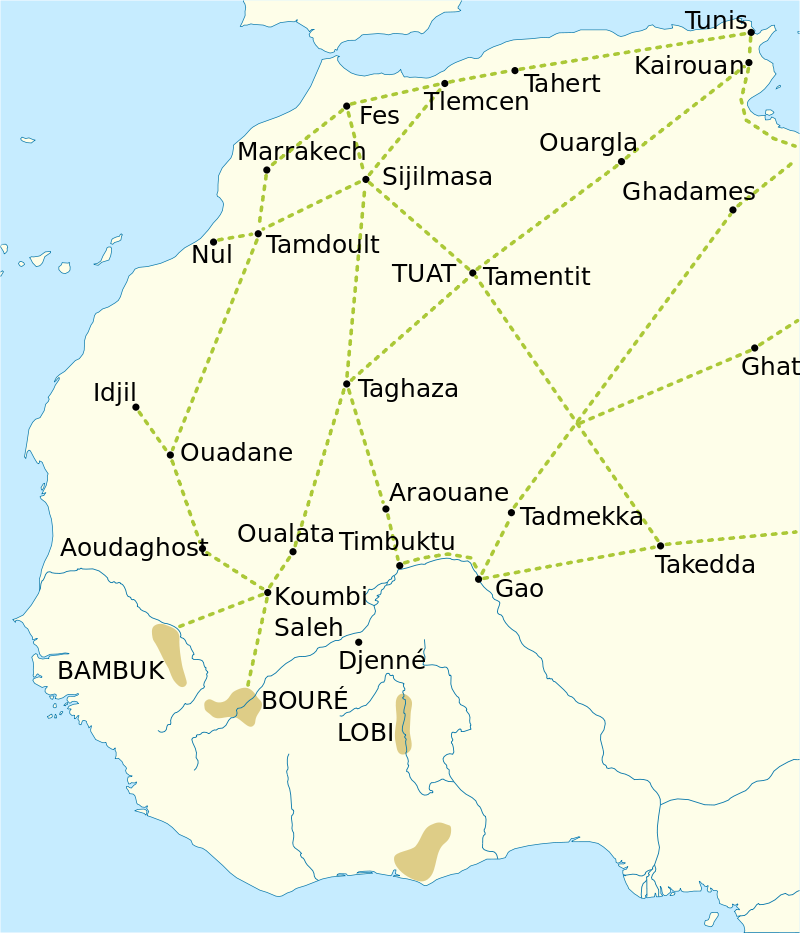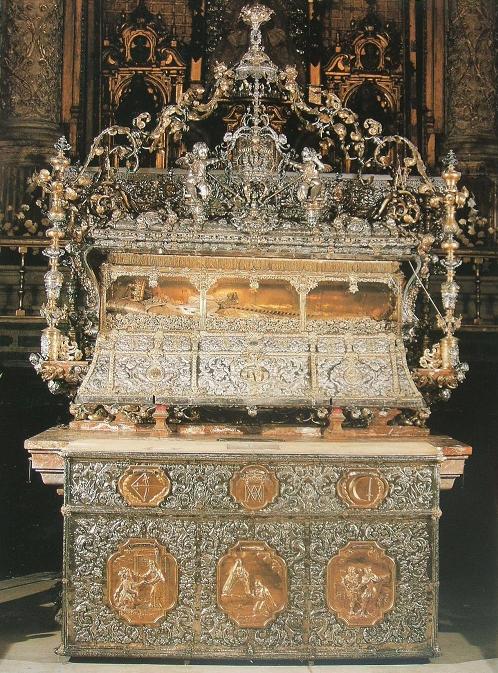The western Sanhaja tribes had been converted to Sunni Islam sometime during the 9th century. They were subsequently united in the 10th century, and with the zeal of new converts, launched several campaigns against the pagan peoples of sub-Saharan Africa. Tribal leaders and alliances came and went, but the vital trans-Saharan trade routes were, in part, supported the Zenata Maghrawa tribe from around Sijilmassa. The Zeneta tribe differentiated itself from other tribes by adopting the name their ancestor, Marin ibn Wartajan al-Zenati, and were originally a nomad tribe who moved seasonally between the Figuig oasis to the Moulouya River basin. With the arrival of the Arabs in the 11th and 12th centuries, the Marinids, as they now called themselves, moved to the north-west of present-day Algeria, before migrating en-masse into Morocco at the beginning of the 13th century.

Saharan camel trade routes and the gold mines of sub-Saharan Africa (in gold)
After arriving in Morocco, the Marinids initially submitted to the Almohad dynasty and even assisted the Amohads at the battle of Alarcos in 1195. Their relationship with the Almohads became strained, and starting in 1215, there were regular outbreaks of fighting between the two tribes. In 1217 they tried to occupy the eastern part of present-day Morocco. They were expelled and pulled back to settle in the eastern Rif mountains, where they remained for nearly 30 years. Meanwhile, the Almohad state suffered huge setbacks, losing land to the Christians in Spain, whilst the Hafsid tribe of Ifriqia broke away in 1229, followed by the Zayyanids of Tlemcen in 1235. Between 1244 and 1248 the Marinids were able to take Taza, Rabat, Salé, Meknes and Fez from the weakened Almohads. Once the Marinids took control of Fes under the leadership of Abu Yusuf Yaqub, they declared war on the Almohads, and with the aid of Christian mercenaries captured Marrakech in 1269.
But we are getting ahead of ourselves. Just about the same time that relations between the Marinids and Almohads had deteriorated to open war in the Rif Mountains, (1212) the Almohads lost the Battle of Las Navas de Tolosa in Iberia, and their leader, Muhammad al-Nasir, returned to Marrakech where he died shortly afterwards. This was the turning point in the Christian reconquest of Iberia.
Immediately after the battle, the much weakened Christians rallied, and King Alfonso took Baeza and then Úbeda, major fortified cities near the battlefield and gateways to the invasion of Andalusia. According to the Latin Chronicle of Kings of Castile, when these two fortresses fell, 60,000 Muslims were killed and 100,000 more were taken into slavery, including women and children. Whilst the Almohads were facing internal conflicts, Alfonso and later kings of Castile and Aragon took advantage of their weakness, and Muslim controlled cities fell like dominoes.
Alfonso VIII's grandson, Ferdinand III of Castile, took Córdoba in 1236, Jaén in 1246, and Seville in 1248. He went on to take Arcos, Medina-Sidonia, Jerez, and Cádiz. Meanwhile, James I of Aragon conquered the Balearic Islands over four years starting in 1228, and Valencia capitulated to him in 1238.
King Ferdinand III was undoubtedly the most successful of the Christian kings, and when he died in 1252 he left a united Castile and León, and his campaigns over 20 years gained more land from the Caliphates than any other. He left some of the captured taifas as Muslim vassal states, which eventually became absorbed into Castile. (Niebla in 1262, Murcia in 1264, Alicante in 1266). Even the powerful Caliphate of Granada was forced to pay tribute to Castile.
He gave parcels of the new lands to his dukes and knights, with the church also receiving a portion of the gains. He added to the University of Salamanca and erected the current Cathedral of Burgos as well as donating to the Benedictine monks and the Cistercians and Cluniacs, who had taken a major role in the Reconquest. In 1252, Ferdinand readied his fleet and army for invasion of the Almohad lands in Africa. But he died in Seville on 30 May 1252 during an outbreak of plague in southern Hispania. Only Ferdinand's death prevented the Castilians from taking the war to the Almohads.
On his deathbed, Ferdinand told his son, Alfonso "you will be rich in land and in many good vassals, more than any other king in Christendom." For the next 200 years, the frontiers would more or less remain static, but the united Christian Iberia that King Alfonso X inherited would be torn apart by civil war and ravaged by the Marinids.

By 1265 the only remaining Muslim governed lands in Iberia were the Nazrid Caliphate of Granada and what was left of the Almohad caliphate.
In Africa, the Marinids led by Abu Yusuf Yaqub, had subdued the last Almohad outpost of Marrakech and he turned his attention on al-Andaluz. He crossed the straits, subdued the isolated Almohad taifas in al-Andaluz, and formed an alliance with the Nazrids to defend and enlarge Muslim controlled parts of Iberia. The fall of so much of Muslim al-andaluz to the Christians, and their subsequent maltreatment, caused a mass Muslim exodus to the caliphates in the south. This added to their strength in numbers, and Abu was fully intent on supplying them with arms and reclaiming their lost lands. But both caliphates had their own problems; Abu Yusuf Yaqub had to deal with constant attacks from the Abdalwadid kingdom of Tlemcen in the Mashriq, and in 1272, the Nasrid ruler Muhammad I faced a challenge from the rival Banu Ashqilula family, who were rulers of Malaga, Guadix and Comares. The reconquest was far from over.
 The tomb of Saint Fernando.
The tomb of Saint Fernando.
King Ferdinand III was interred in the Cathedral of Seville by his son, King Alfonso X. His tomb is inscribed in four languages: Arabic, Hebrew, Latin, and an early version of Castilian. Today, the uncorrupted body of Saint Fernando can still be seen in a gold and crystal casket. His golden crown still encircles his head as he reclines beneath the statue of the Virgin of the Kings.